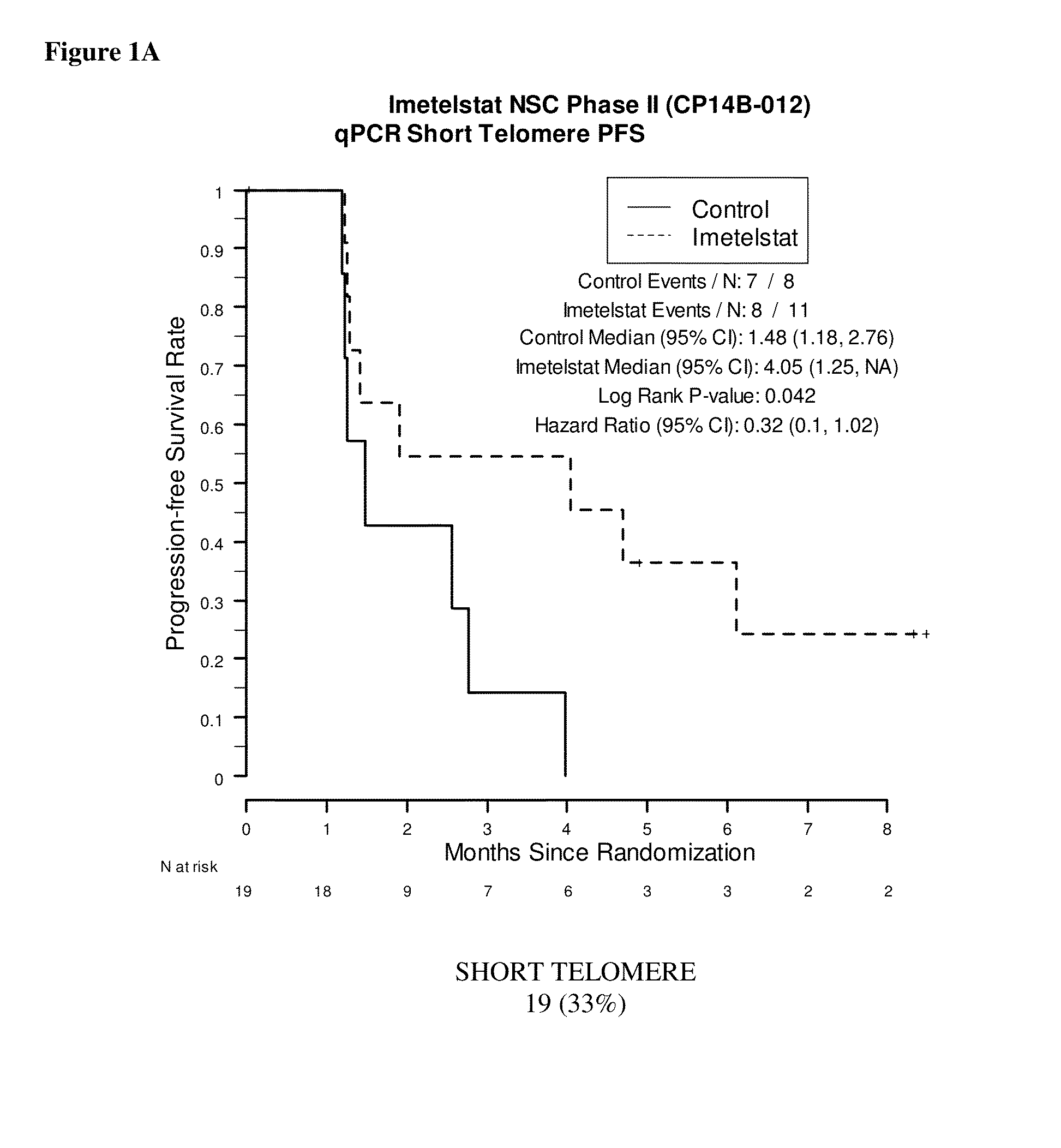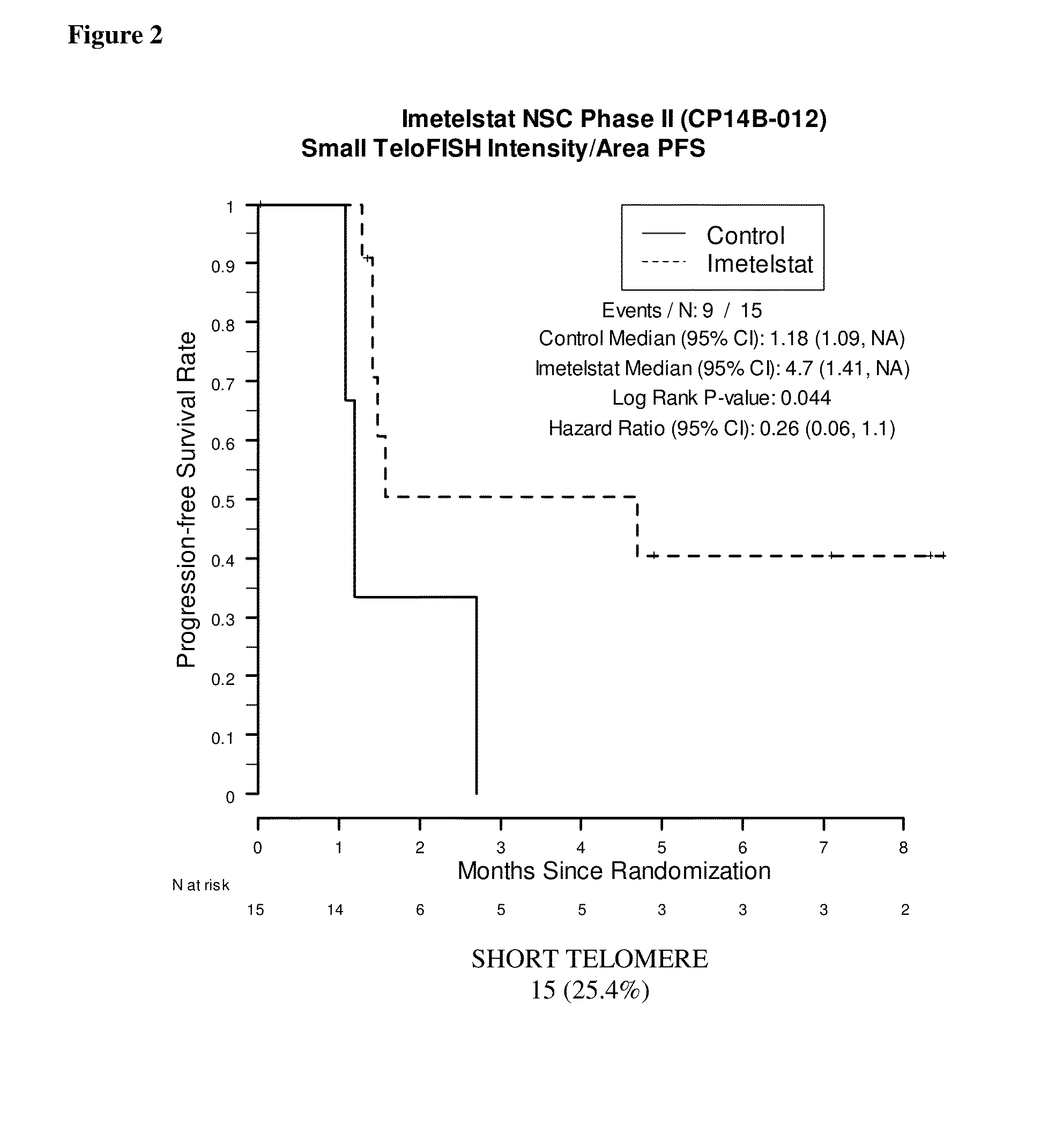Diagnostic markers for treating cell proliferative disorders with telomerase inhibitors
a technology of telomerase inhibitors and diagnostic markers, which is applied in the direction of gene therapy, biochemistry apparatus and processes, medical preparations, etc., can solve the problems of decreased cancer cell proliferation and/or tumor growth, and increased progression free survival in individuals. , to achieve the effect of reducing cellular proliferation, reducing cancer cell proliferation and/or tumor growth, and reducing tumor growth
- Summary
- Abstract
- Description
- Claims
- Application Information
AI Technical Summary
Benefits of technology
Problems solved by technology
Method used
Image
Examples
example 1
Preparation and Lipid Conjugation of Oligonucleotide N3′→P5′ Phosphoramidates (NP) or N3′→P5′ Thiophosphoramidates (NPS)
[0152]This example shows how to synthesize lipid conjugated Oligonucleotide N3′→P5′ Phosphoramidates (NP) or N3′→P5′ Thiophosphoramidates (NPS).
Materials and Methods
[0153]Starting Compounds
[0154]These compounds may be prepared as described, for example, in McCurdy et al., Tetrahedron Letters 38: 207-210 (1997) or Pongracz & Gryaznov, Tetrahedron Letters 49: 7661-7664 (1999). The starting 3′-amino nucleoside monomers may be prepared as described in Nelson et al., J. Org. Chem. 62: 7278-7287 (1997) or by the methods described in Gryaznov et al., US Application Publication No. 2006 / 0009636.
[0155]Lipid Attachment
[0156]A variety of synthetic approaches can be used to conjugate a lipid moiety L to the oligonucleotide, depending on the nature of the linkage selected; see, for example, Mishra et al., Biochim. et Biophys. Acta 1264: 229-237 (1995), Shea et al., Nucleic Acid...
example 2
qPCR on Formalin-Fixed, Paraffin-Embedded Samples from Imetelstat NSC Phase II (CP14B-012) Study
[0163]This example demonstrates the performance of the quantitative polymerase chain reaction for determining the relative telomere length of FFPE NSC Phase II (CP14B-012) Study tissue samples.
Materials and Methods
[0164]Clinical Trial Design
[0165]The purpose of the NSC Phase II (CP14B-012) Study was to evaluate the efficacy and safety of imetelstat (GRN163L) as maintenance therapy for patients with advanced stage non-small cell lung cancer who have not progressed after 4 cycles of platinum based therapy. Participants were randomized in a 2:1 ratio to imetelstat plus standard of care versus standard of care alone. Participants who received bevacizumab with their induction chemotherapy continued to receive bevacizumab in this study.
[0166]The primary outcome measures were progression-free survival, defined as the time from randomization to documented disease progression or death, whichever o...
example 3
Telo-FISH on Formalin-Fixed Paraffin-Embedded Samples from NSC Phase II (CP14B) Study
[0188]Samples were obtained from 61 of the 116 patients enrolled in the NSC Phase II (CP14B-012) Study described above. Of these 61 patient samples, 59 resulted in evaluable Telo-FISH assay results used for PFS analysis. Each assay produced data for between 7 and 14545 foci from six regions (‘fields’) on a slide. The area and fluorescent intensity were recorded for each of the foci.
Materials and Methods
[0189]Unstained FFPE tissue slides (5 μm thick tissue sections) were prepared by routine histological methods. The tissue slides were preheated at 65° C. for 6 minutes to melt the paraffin, then loaded onto a slide rack. The loaded slide rack was immersed in 100 mL of xylene in a staining tank for 3 minutes two times (3 minutes×2) to remove paraffin.
[0190]The slides were then hydrated in 3-minute increments through a graded ethanol series: 100% EtOH, (3 minutes×2), 95% EtOH (3 minutes×2), and 70% EtOH...
PUM
| Property | Measurement | Unit |
|---|---|---|
| relative telomere length | aaaaa | aaaaa |
| length | aaaaa | aaaaa |
| length | aaaaa | aaaaa |
Abstract
Description
Claims
Application Information
 Login to View More
Login to View More - R&D
- Intellectual Property
- Life Sciences
- Materials
- Tech Scout
- Unparalleled Data Quality
- Higher Quality Content
- 60% Fewer Hallucinations
Browse by: Latest US Patents, China's latest patents, Technical Efficacy Thesaurus, Application Domain, Technology Topic, Popular Technical Reports.
© 2025 PatSnap. All rights reserved.Legal|Privacy policy|Modern Slavery Act Transparency Statement|Sitemap|About US| Contact US: help@patsnap.com



